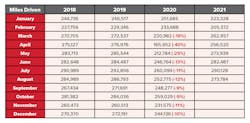Readers of this column know that I am not afraid to make predictions. I don’t have a specific formula, but I’ve been around long enough to recognize signs that tire supplies or prices are about to become an issue. Natural rubber, for example, is a reliable indicator of tire prices. When natural rubber rises, that’s a bad sign for tire manufacturers—especially those in the truck tire space since they have a higher natural rubber content than passenger and light-truck tires. FYI, the price has been falling in the past few months—and that’s a good sign.
Beyond that, there are several other factors that I consider before going out on the limb to make another attempt at a prediction. One is the monthly trend in traffic volume published by the Federal Highway Administration (FHWA), which collects data at around 5,000 continuous traffic counting locations spread out across every state to estimate the number of miles driven for a particular month on rural and urban roads and highways. The estimates are adjusted to match data from the Highway Performance Monitoring System, so they are continually updated to reflect the most accurate picture of year-to-year performance.
See also: Overcoming tire supply and maintenance woes
My most recent foray into the FHWA miles-driven data revealed some telling signs about the state of the tire market. The data from 2018 until now really describes what has happened over the last year and a half. First, the drop in March 2020 was significant when compared to 2019; however, it was nothing compared to the drop the following month. COVID-19 caused miles driven to drop 40% when compared to April 2019.
From 1995 to 2019, total miles driven has only dropped year-to-year a handful of times. From 2007 to 2008, it dropped around 3.6%; from 2008 to 2009, total miles driven dropped by 0.16%. From 2010 to 2011, it dropped another 0.16%. As percentages, the number seems negligible, but in actual miles, it represented more than 56 billion miles less for 2007-2008 and almost 17 billion fewer miles in 2008-2009 and 2010-2011. The 40% drop between April 2019 and April 2020 represented more than 111 billion miles that weren’t traveled.
To put that into perspective, a deeper dive of miles driven going back to 1970 revealed a drop from 1973 to 1974 of more than 18 billion miles, a decrease of 19 billion miles from 1978 to 1979, and a drop of just over 8 billion miles from 1979 to 1980. Outside the pandemic, miles driven has only dropped year-to-year a total of six times over the past 50 years.
In 1973, the oil embargo was to blame, while the energy crisis in the aftermath of the Iranian Revolution caused the drops from 1978 to 1980. Throw in the global recession from 2008 to 2010, and all the yearly drops in mileage over the past 50 years combined are just 24 billion miles more than the monthly drop from April 2019 to April 2020.
See also: Discount Tire to acquire Tire Rack
Everything shut down in the earliest days of the pandemic—including tire and commercial vehicle manufacturing facilities—because we didn’t know what we were dealing with. It was a once-in-a-generation event with effects that are still being felt across the supply chain today. Looking at the 2021 data, it’s obvious that miles driven has rebounded significantly from 2020 and, in some instances, it has almost returned to 2019 levels when compared month-to-month.
September 2021 data hasn’t been published, but I’m guessing that we will see similar results with a sizable increase when compared to September 2020 yet a few billion miles short of September 2019. The entire global supply chain for commercial truck tires can’t just stop for a few months and then restart with an instant return to normal production levels. Increased demand from OEMs only makes matters worse, which is another key indicator of truck tire supply and prices.
We are facing unprecedented times, and the FHWA data proves that point. The pressures on trucking and truck tires are going to increase as we return to whatever the new normal will be. I haven’t seen any signs that the market is going to stabilize any time soon, especially with rising oil and energy costs. If miles traveled continues to rebound, then expect more challenges.
Kevin Rohlwing is the SVP of training for the Tire Industry Association. He has more than 39 years of experience in the tire industry and has created programs to help train more than 180,000 technicians.
About the Author
Kevin Rohlwing
Kevin Rohlwing is the SVP of training for the Tire Industry Association. He has more than 40 years of experience in the tire industry and has created programs to help train more than 180,000 technicians.

